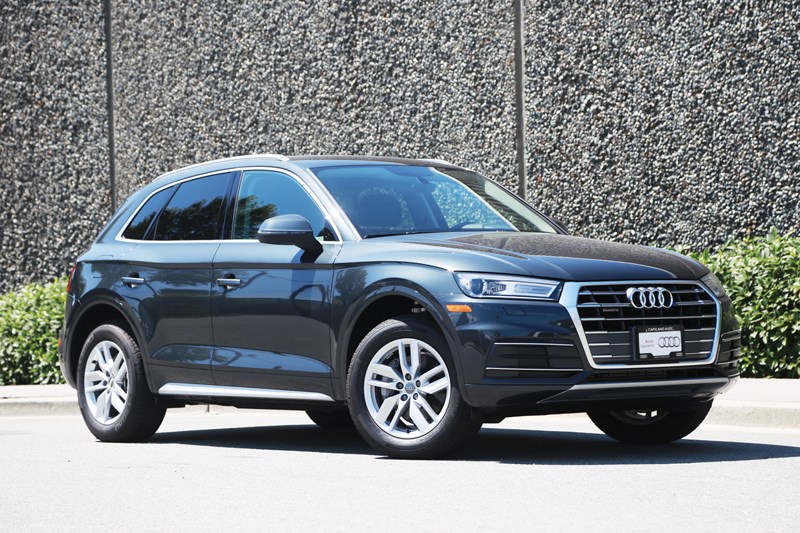It’s hard to believe, but Audi’s ever-popular Q5 model has been in existence since 2008.
It stayed more or less the same – though there was a slight refresh in 2013 – over the years but it’s finally ready for a complete makeover.
The 2018 version is long overdue, and it arrives as a brand new model that also has a base in a brand new factory in Mexico. Yes the 2018 Q5 is now produced in Audi’s San Jose Chiapa plant in Mexico’s Puebla region – the factory is Audi’s newest and greatest with more than $1 billion in investment supported by 3,300 employees. This is now the only factory in the world that produces the Q5, so it’s a significant move by Audi to consolidate the production to a single, somewhat unproven site. This factory has some of the most innovative manufacturing technologies in the world.
Audi made important upgrades throughout the car, including an adoption of numerous aluminum parts, reducing the weight by more than 90 kilograms.
The Q5 has sold more than 1.6 million worldwide, making it one of the most popular models in its class.
Design
Audi stayed true to its heritage by keeping much of the overall design feel intact from the 2017 model; so much so that an average person may not spot the 2018s as “new.” This was intentional, of course, because the previous model had such a loyal base and there was no reason to take a chance and radically change the design of the Q5.
Having said that, the 2018 Q5 has softer, cleaner lines and a rounded, sculpted side profile that’s attractive and modern. The front end borrows from the Q7’s look and feel while retaining the Q5’s unique design.
While the final result is a car that won’t disappoint anyone – particularly those who liked or owned the previous versions of the Q5s – I wish that Audi designers took a tiny bit more risk by incorporating trendier innovative design elements and features. The car is pretty, but it looks so much like the 2017s.
The interior is a beautiful combination of modern touches and elegant finishes. The car has ergonomically designed buttons and switches that are on the minimalist side, thanks to clever use of a larger infotainment system. The new modular infotainment system offers improved capability all around but it’s also capable of connecting with smartphones via Apple CarPlay or Android Auto.
Audi’s best-in-the-industry Virtual Cockpit is outstanding as always, though not everyone will like the idea of having all the information on the electronic dashboard versus having real buttons and controls.
Performance
The best way to assess the new Q5’s performance capability is to simply drive this car back-to-back with the likes of BMW X3, Lexus RX, or Mercedes GLC SUVs. It would be immediately obvious that Audi has the best balance of road feel and comfort, providing that perfect “just right” feel that’s hard to replicate these days. Cars like the X3 (which is about to change) are ever so popular, but these SUVs are so soft to drive that all sense of driving fun is often taken out. Not so with the Q5, which still retains a good driving feel.
The exception may be the Mercedes GLC, which also has a great sense of steering feel and feedback that provides a decent fun-factor experience.
The Lexus RX – another volume leader in this class – has amazing design and features but its ride and handling is boring, though refined. Driving the RX feels like driving an older American vehicles from years ago – it’s no match to Audi’s much tighter, sportier feel that provides boosted confidence in all road conditions.
On the engine side, the only powertrain that is available is Audi’s 2.0-litre gasoline turbo four, producing 252 horsepower and 273 foot-pounds of torque. That’s plenty for this vehicle and provides a brisk, comfortable acceleration. The lighter body contributes to improved 0 to 100 kilometre per hour acceleration times of about 6.3 seconds, making it one of the fastest four-cylinder SUVs. There are no diesels planned, thanks to the scandals that virtually killed the diesel market in North America.
The ride is compliant and, in a typical German fashion, stable over highway speeds. There is an available adaptive and adjustable suspension, but even the baseline is great in its ability to absorb bumps. Like all European models, the ride is stiffer and firmer than either the American or Japanese competitors.
The fuel efficiency is still good with 10.4 (litres/100 kilometres) in the city and 8.6 on the highway. The prices start at $44,950 for the base Komfort model and runs all the way to $54,200 in the Technik format.
The Q5 line is also available in the sporty SQ5 version, which delivers much punchier acceleration along with better handling and fancier looks. The air suspension which is new for 2018 is also only available on the higher spec SQ5.
Summary
If you want that German or European feel in a car with firmer and more predictable road manners, you simply cannot get that in typical Asian or North American SUVs these days (with some exceptions). And the Q5 has been one of the best performers so far, with above average reliability which may have changed with the new factory coming online.
With good resale values and continuing demand for Audi SUVs worldwide, this car will always outperform most other vehicles in this class.
Latest prices and specification are available on Audi’s website at: audi.ca.



